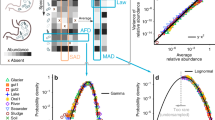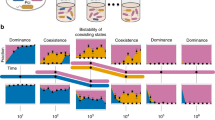Summary
Forty communities were assembled through the controlled inoculation of algae, protozoans and a rotifer according to either of 2 distinct introduction schedules. These introduction schedules were constructed such that species reinvaded on average either every 6 or 8 w. Ten of the 20 beakers experiencing each invasion schedule contained 300 ml of media; the remaining beakers in each invasion category contained 100 ml of media. Species richness consistently increased throughout the initial 4 w and 7 w of the experiment for the low and high invasion rate beakers, respectively. The numbers of species in the low rate beakers were uncorrelated with time during the last half of the experiment; however, species richness gradually declined during this period in the high rate beakers. The extinction rate is shown to be disproportionately higher for large organisms in the small microcosms. Such “selective extinction” is consistent with the MacArthur-Wilson equilibrium model.
Similar content being viewed by others
References
Armstrong JT (1965) Breeding home range in the nighthawk and other birds; its evolutionary and ecological significance. Ecology 46:619–629
Bold HC, Wynne MJ (1978) Introduction to the algae: structure and reproduction. Prentice Hall, Englewood Cliffs, New Jersey, p 706
Bonner JT (1965) An essay on the structure of biology. Princeton Univ Press, Princeton, NJ, p 219
Bradley JV (1968) Distribution-free statistical tests. Prentice Hall, Englewood Cliffs, New Jersey, p 388
Brown JH, Kodric-Brown A (1977) Turnover rates in insular biogeography: effect of immigration on extinction. Ecology 58:445–449
Carlquist S (1974) Island biology. Columbia University Press, New York, p 660
Damuth J (1981) Population density and body size in mammals. Nature 290:699–700
Diamond JM (1969) Avifaunal equilibria and species turnover rates on the Channel Islands of California. Proc Nat Acad Sci USA 64:57–63
Diamond JM (1975) Assembly of species communities. In: Cody ML, Diamond JM (eds) Ecology and evolution of communities. Belknap Press, Cambridge, Mass, pp 342–444
Diamond JM (1976) Island biogeography and conservation: strategy and limitations. Science 193:1027–1029
Dickerson JE (1983) Microcosms as islands: a test of the MacArthur-Wilson equilibrium theory. M. Sc. thesis, The University of Texas at Arlington
Dickerson JE, Robinson JV (1984) The assembly of microscopic communities: patterns of species importance. Trans Am Microsc Soc 103:164–171
Dickerson JE, Robinson JV (1985) Microcosms as islands: a test of the MacArthur-Wilson equilibrium theory. Ecology 66:966–980
Fowler CW, MacMahon JA (1982) Selective extinction and speciation: their influence on the structure and functioning of communities and ecosystems. Am Nat 119:480–498
Gause GF (1934) The struggle for existence. Hafner, New York, NY p 163
Jones HL, Diamond JM (1976) Short-time-base studies in turnover in breeding bird populations on the California Channel Islands. Condor 78:526–549
MacArthur RH (1972) Geographical ecology: patterns in the distribution of species. Harper and Row, New York, p 269
MacArthur RH, Wilson EO (1963) An equilibrium theory of insular zoogeography. Evolution 17:373–387
MacArthur RH, Wilson EO (1967) The theory of island biogeography. Princeton University Press, Princeton, New Jersey, p 203
McNab BK (1963) Bioenergetics and the determination of home range size. Am Nat 97:133–140
Nichols HW (1973) Growth media-freshwater. In: Stein JR (ed) Handbook of phycological methods. Cambridge University Press, Cambridge, UK, pp 7–24
Power DM (1972) Numbers of bird species on the California Islands. Evolution 43:185–215
Rey JR (1981) Ecological biogeography of arthropods on Spartina islands in northwest Florida. Ecol Monogr 51:237–265
Schoener TW (1968) Sizes of feeding territories among birds. Ecology 49:123–141
Schoener A, Schoener TW (1981) The dynamics of the species-area relation in marine fouling systems: 1. biological correlates of changes in the species-area slope. Am Nat 118:339–360
Schoener T, Schoener A (1983) Distribution of vertebrates on some very small islands. II. patterns in species number. J Anim Ecol 52:237–262
Simberloff D (1976) Experimental zoogeography of islands: effects of island size. Ecology 57:629–648
Simberloff DS, Abele LG (1974) Island biogeography and conservation: strategy and limitations. Science 193:1032
Simberloff DS, Wilson EO (1969) Experimental zoogeography of islands: the colonization of empty islands. Ecology 50:278–296
Strong DR, Rey JR (1982) Testing for MacArthur-Wilson equilibrium with the arthropods of the miniature Spartina archipelago at Oyster Bay Florida. Am Zool 22:355–360
Taylor WD, Schuter BJ (1981) Body size, genome size, and intrinsic rate of increase of ciliated protozoa. Am Nat 118:160–172
Turner FB, Jennrich RI, Weintraub JD (1969) Home ranges and body size of lizards. Ecology 50:1076–1081
Whitehead DR, Jones CE (1969) Small islands and the equilibrium theory of island biogeography. Evolution 23:171–179
Author information
Authors and Affiliations
Rights and permissions
About this article
Cite this article
Dickerson, J.E., Robinson, J.V. The controlled assembly of microcosmic communities: the selective extinction hypothesis. Oecologia 71, 12–17 (1986). https://doi.org/10.1007/BF00377313
Received:
Issue Date:
DOI: https://doi.org/10.1007/BF00377313




